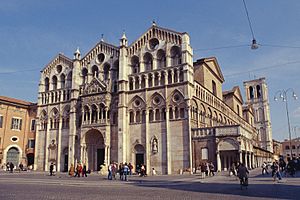Nicola Vicentino facts for kids
Nicola Vicentino (born 1511 – died 1575 or 1576) was an Italian music theorist and composer from the Renaissance period. He was known for his very new ideas in music. One of his most famous inventions was a special keyboard that could play microtonal music.
Contents
Life Story
We don't know much about Nicola Vicentino's early life. He was born in Vicenza, Italy. He might have studied music in Venice with a famous musician named Adrian Willaert. Vicentino became very interested in old Greek music ideas and how they were played. Scholars like Girolamo Mei were just starting to learn more about this.
Time in Ferrara
In the 1530s or early 1540s, Vicentino moved to Ferrara. This city became a major center for new and experimental music in Italy. He likely taught music to the Duke of Ferrara's family. Some of his music was even performed at the Duke's court.
The Great Music Debate
By the late 1540s, Vicentino was becoming well-known for his ideas about music. In 1551, he took part in a famous debate in Rome with another musician, Vicente Lusitano. They argued about how ancient Greek musical scales, called genera, related to the music of their time.
Lusitano believed that current music could be explained using only the simple diatonic scale. But Vicentino thought that music was a mix of diatonic, chromatic, and enharmonic scales. The enharmonic scale used very small notes, called microtones. The judges of the debate decided that Lusitano was right. Even so, Vicentino later published his ideas in 1555. His book influenced many composers who came after him.
His Amazing Invention
After the debate, Vicentino kept working on his ideas. He built a special keyboard instrument called the archicembalo. This instrument could play the unique music he described in his writings. Only one keyboard from that time, built in 1606, still exists today. It can play diatonic, chromatic, and enharmonic music. You can see it at the International museum and library of music in Bologna.
Later Years
After a short time in Rome, Vicentino went back to Ferrara. Later, he moved to Siena. In 1563, he became the music director at Vicenza Cathedral, returning to his hometown. But he only stayed a short time before moving to Milan in 1565. He might have had some connection with the court in Munich around 1570. Nicola Vicentino died in Milan during a terrible plague between 1575 and 1576. We don't know his exact death date.
Musical Works and Ideas
While Vicentino wrote music, like two books of madrigals and motets, he was most famous for his ideas about music theory. His music was known for its complex harmonies.
New Musical Sounds
In the 1550s, many musicians in Italy became very interested in "chromatic" music. This meant using many notes that were not in the main scale, creating new sounds. Some of this was part of a movement called musica reservata. Other musicians were inspired by old Greek music. Composers like Cipriano de Rore wrote music that was hard to sing perfectly in tune without special adjustments. Many music thinkers, including Vicentino, tried to solve this problem.
His Most Famous Book
In 1555, Vicentino published his most important book, L'antica musica ridotta alla moderna prattica. This title means "ancient music adapted to modern practice." In this book, he fully explained his ideas about connecting old Greek music theory with the music of his time. He also defended the ideas he had in his debate with Lusitano. Vicentino's book was very important for the madrigal composers in Ferrara, like Luzzasco Luzzaschi and Carlo Gesualdo.
Music Volume
Vicentino also did original work on how loud or soft music should be played. He was one of the first music thinkers to talk about volume as a way to express feelings in music. In his book, he said that singers should change how loud they sing to match the words and mood of the song.
The Archicembalo and Arciorgano
Vicentino's most famous invention was the archicembalo. This keyboard had 31 keys for each octave (instead of the usual 12). With this instrument, musicians could play musical intervals that sounded perfectly in tune in any key. This meant that the new chromatic music, which often sounded best when sung, could now be played on a keyboard.
Later, he used the same keyboard design for the arciorgano, which was a microtonal organ. These special keyboards were not used by everyone, but they offered a way to play music with very good tuning for certain notes. Today, most keyboard instruments use a system called 12-tone equal temperament. This system divides the octave into 12 equal parts, which makes it easy to play in all keys, but some notes like major and minor thirds don't sound perfectly in tune. Vicentino's 31-note system offered a different solution, giving good tuning for thirds and sixths.
Images for kids
See also
 In Spanish: Nicola Vicentino para niños
In Spanish: Nicola Vicentino para niños







